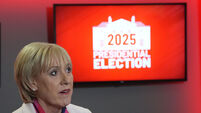Waterford’s global brand may be approaching the point of departure
The iconic glassware manufacturer has brought the name of its host city around the world as pieces of beautiful handcut Irish-made crystal have been sold and collected in many countries or presented as recognition of achievement or excellence.
Further proof of this iconic status comes from the tens of thousands who annually attend the successful visitors’ centre in the city, especially the number who come from the US.
These people probably would not go to the south-east of the country while in Ireland were it not for the opportunity to visit and watch the incredible skill of the glass-blowers and their handicraft on display. The company gets sales and the region gets tourism. The employees of the company get large wages and the jobs and incomes of many people beyond Waterford Crystal are enhanced by its presence.
It seems like a win-win no-brainer and something that has to be protected all costs for benefit of the region and the country. But it’s not that simple.
Unfortunately, Waterford Wedgwood (WW) — the stock market-listed holding company controlled by Tony O’Reilly — is in deep financial trouble. It is not beyond the bounds of possibility that it could go out of business without radical reform, such as moving its manufacturing operations out of expensive Ireland to low-cost locations such as Indonesia or eastern Europe.
About €775 million has been raised in the last five years through share sales, bond issues and asset disposals — with more than €300m coming from O’Reilly and his equally generous brother-in-law Peter Goulandris — but even after all of that WW is valued by the stock market at just €80m. It’s annual losses run to over €100m each year.
The group’s last reported debt level was €473.4m six months ago and it’s clear the banks won’t advance more loans without guarantees from the likes of O’Reilly or the Government.
And this is where the problem lies. Why not let O’Reilly take his own risks? Despite his Irish nationality and considerable business interests here, he is “non-resident” to reduce his personal tax liabilities to the very exchequer from which he wants help.
But O’Reilly, even though his assets have been valued at over €2 billion, has risked more of his fortune on saving WW than most men would.
He can scarcely risk more, especially as he knows his control of Independent News and Media is under threat and that he needs money to defend that.
However, the banks — which are very nervous institutions these days and most unwilling to lend money — won’t offer loans without firm guarantees that the money will be repaid even if the company cannot generate enough cash itself. Which is why the Government has been asked to risk €36m of exchequer funds to assist in bailing out WW as owner of Waterford Crystal. WW is not looking for a cash grant or gift. It does not want to have to call on the money at all if possible.
But there are all sorts of reasons why the Government may not act. Even if it wanted to, the European Commission might block it on the grounds of anti-competitive and unfair state aid that would disadvantage other glassware-makers in member states.
Even if the EU said ‘yes’, there would also be a problem involved with creating precedent.
Should the Government then, for example, move to bail out Iralco in Co Westmeath, the car parts manufacturer that went into liquidation, costing 420 jobs (once it had 900 in a tiny rural area that has little else)?
What other companies would then look for similar support? The timing of Waterford’s request is very unfortunate also because the exchequer is running out of money and the Government has to exercise more discretion about what it spends.
Based on past performance and future trends, and given the credit rating of the WW group, there must be a substantial risk of the company defaulting on loan repayment and of the Government being stung.
Waterford Crystal’s John Foley last week compared possible State support to what the British government recently did for the failing bank Northern Rock, but the comparison is ridiculous.
A collapse of Northern Rock led to the risk of systemic failure in the entire British financial system. The impact to the Irish economy of Waterford Crystal closing would by tiny by comparison.
And there’s another twist, which ironically makes the plight of the Irish manufacturing operations of Waterford simultaneously more and less worthy of support.
Following the latest redundancy programme reducing the workforce by 490 people to just 550 (compared to the 3,200 who worked once in the Irish plants), it is possible that Waterford Crystal is actually profitable.
Which then raises the question as to why it needs support and why it would shut? The reason is strategic and management failure on the part of the overall group’s owners. WW owns four main businesses: Waterford Crystal, Rosenthal, Wedgwood and Royal Doulton (the latter two operating in ceramics). It appears that the even greater financial failures of the ceramics companies have weighed down the glass divisions. However, while the company’s accounts show the crystal division can make profits before interest charges, it is not clear how much of the profitability is down to outsourced production.
In any case the group is weighed down by its overall debt at a time when the profit margin on sales of all products are under further threat for two big reasons: the weakness of the dollar and the downturn in consumer spending. With US sales accounting for about 40% of all group revenues, the purchase of expensive luxury goods will be a low priority for most people. Even if local manufacturing is profitable, before interest costs, it might not remain that way for long.
THE company is being forced by its new external investors to cut costs and the banks will encourage that. Shedding jobs is one way of doing it. The Irish manufacturing operations could be transferred to a third world or, more probably, eastern European location to save a fortune in operating costs.
A more ruthless man than O’Reilly would have shifted production to far cheaper locations a decade ago. The company could employ 1,300 staff in Indonesia for the cost of fewer than 100 in Ireland. It seems that genuine pride in the Irish home of the company has influenced O’Reilly. He may have made mistakes with his overall strategy for the group, but his loyalty to Waterford cannot be denied. He has kept Waterford on the map.
The Government may be inclined instead to help Waterford by upgrading the local institute of technology to a university, for example. There has been a sizeable and vocal campaign, with many advocates not just from the south-east but outside the area, to do this and the Government, having received a report from independent consultants, is examining the issue. Whether Munster, which already has two universities, needs another is a moot point, especially as third and fourth-level education standards could be diluted, but I suspect this is the decision more relevant to keeping Waterford on the map in the future.
The Last Word with Matt Cooper is broadcast on 100-102 Today FM, Monday to Friday, 4.30pm to 7pm.





